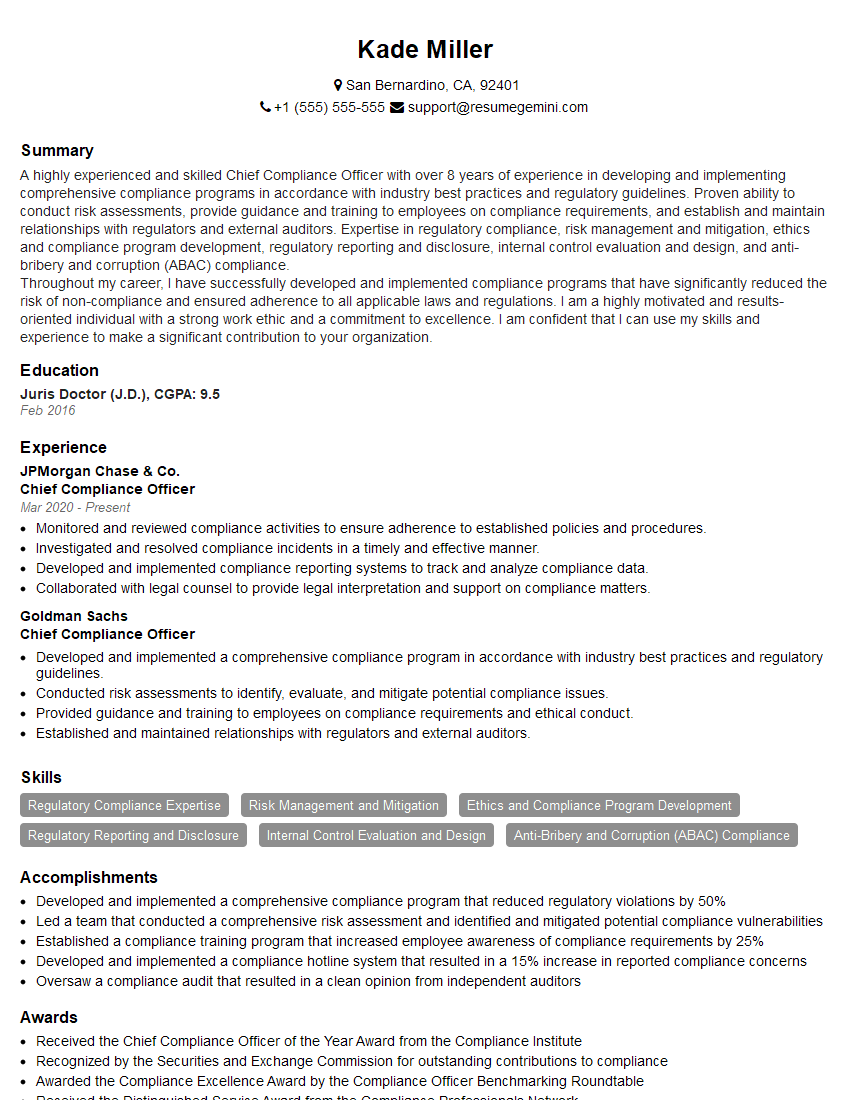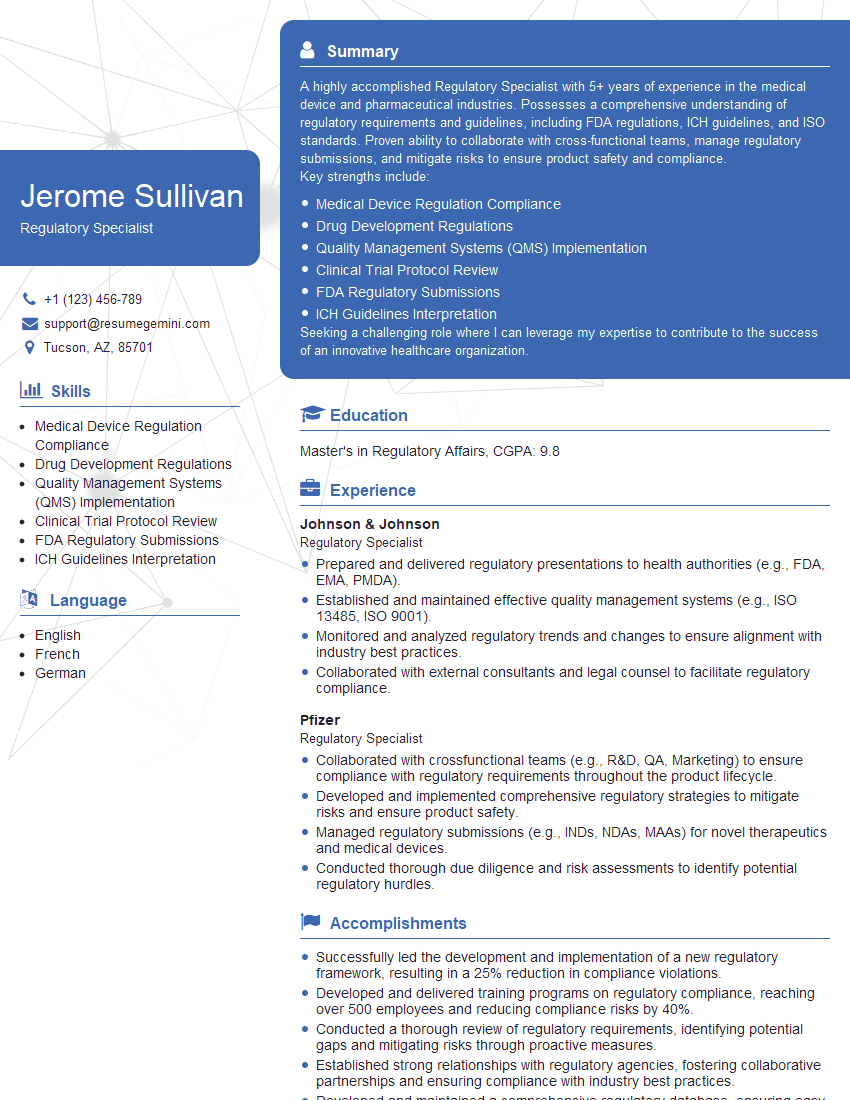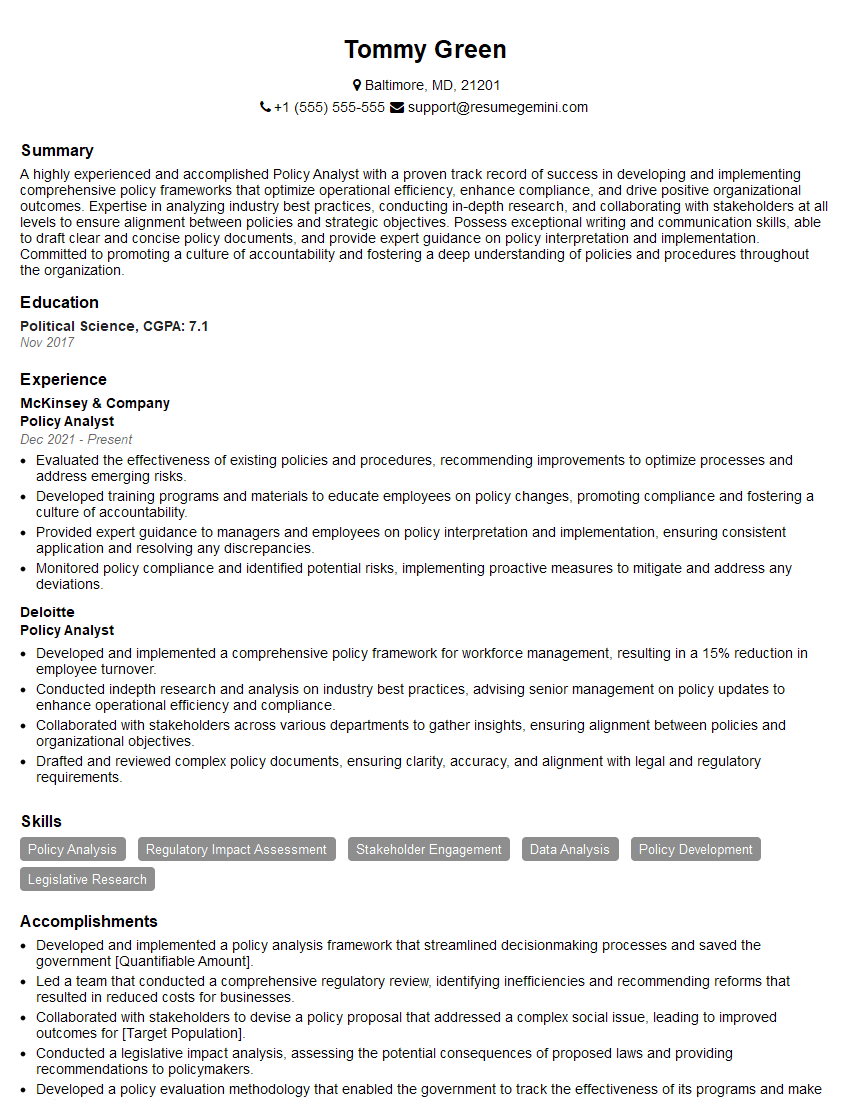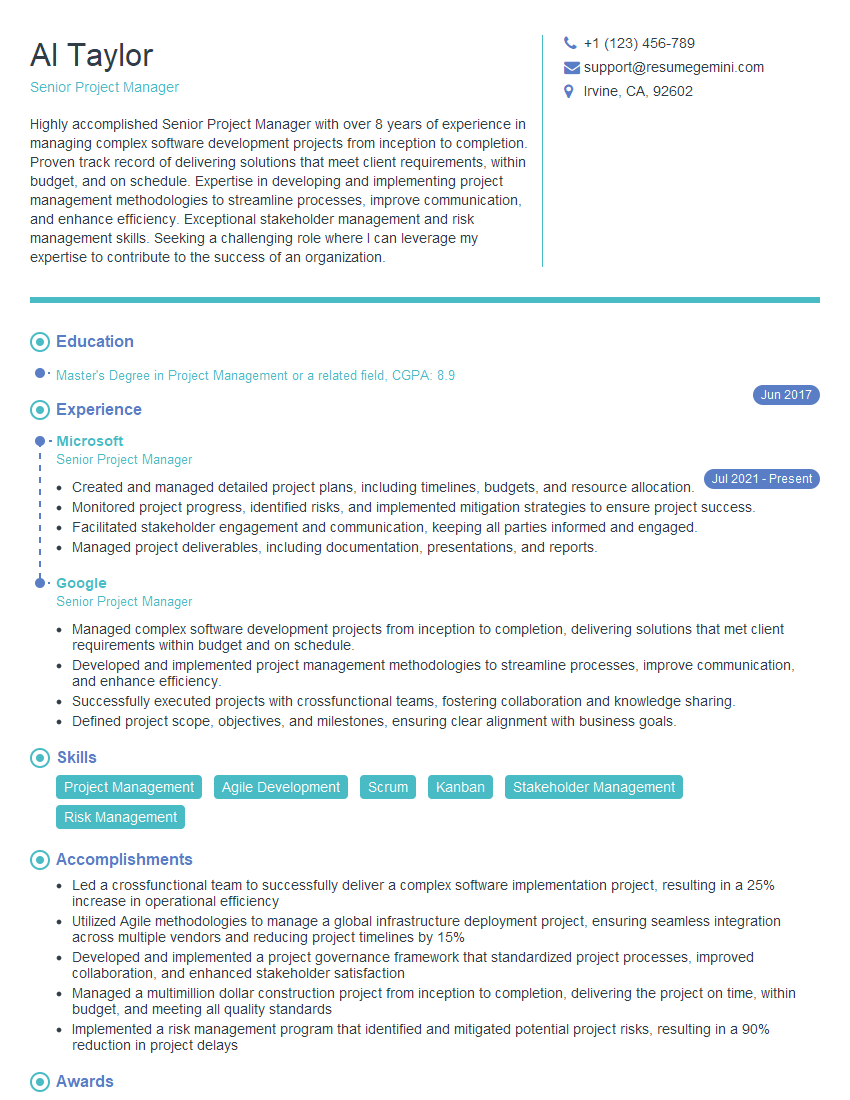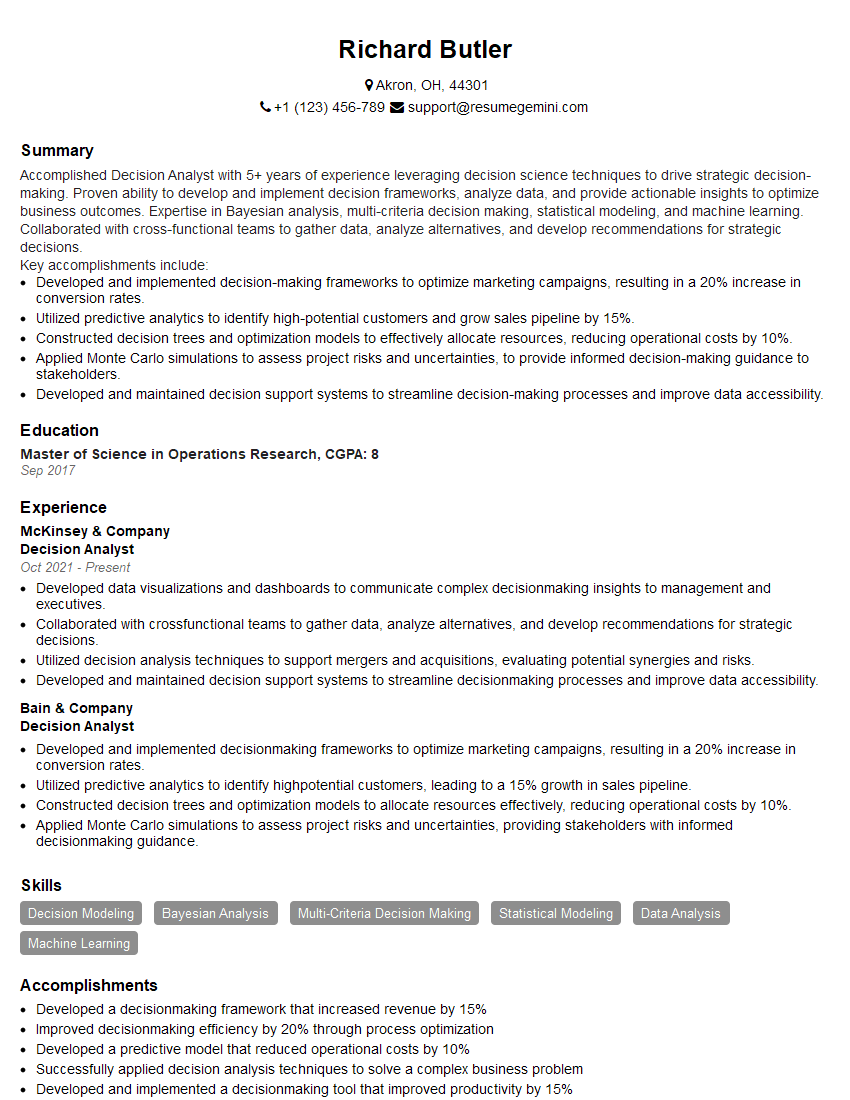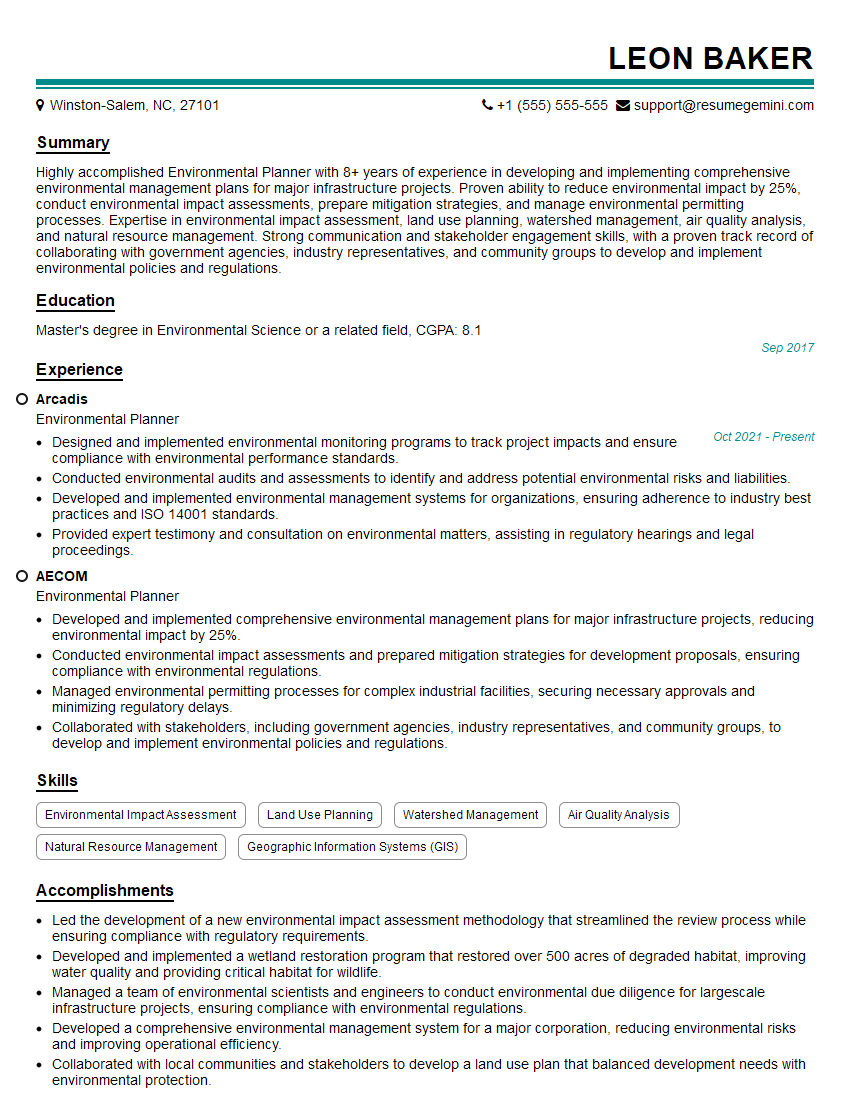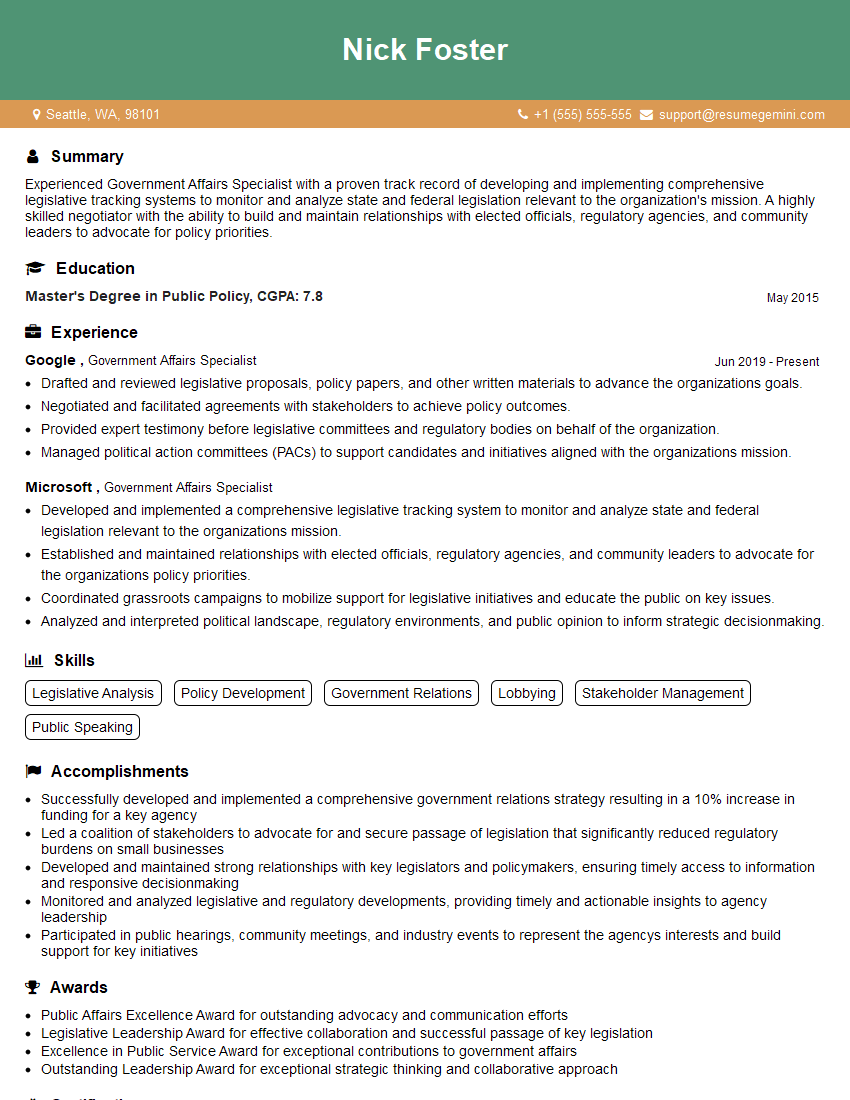Feeling uncertain about what to expect in your upcoming interview? We’ve got you covered! This blog highlights the most important Record of Decision interview questions and provides actionable advice to help you stand out as the ideal candidate. Let’s pave the way for your success.
Questions Asked in Record of Decision Interview
Q 1. Explain the purpose and significance of a Record of Decision (ROD).
A Record of Decision (ROD) is a crucial document that formally documents the decision of a federal agency on a proposed action that has undergone environmental review under the National Environmental Policy Act (NEPA). Think of it as the final verdict after a thorough investigation. Its significance lies in its legal weight; it signals the agency’s commitment to a specific course of action and triggers the implementation phase of the project. The ROD ensures transparency and accountability, allowing the public to understand the agency’s reasoning and decision-making process.
Q 2. Describe the key components typically included in a ROD.
A typical ROD includes several key components. First, it clearly states the agency’s decision regarding the proposed action. Second, it summarizes the environmental impacts of the chosen alternative, referencing the supporting Environmental Impact Statement (EIS) or Environmental Assessment (EA). Third, it discusses the rationale behind selecting the preferred alternative, outlining why it was chosen over other options considered. Fourth, it identifies any mitigation measures to minimize negative environmental impacts. Finally, it often outlines the next steps in the project’s implementation and monitoring process. Think of it like a detailed summary of a lengthy report, highlighting the key findings and decisions.
Q 3. What are the legal requirements for developing a ROD?
The legal requirements for developing a ROD are primarily dictated by NEPA and its implementing regulations. Agencies must follow a structured process, including scoping (defining the scope of the environmental review), preparation of an EIS or EA, public comment periods, and careful consideration of alternatives. The ROD itself must be clear, concise, and accurately reflect the agency’s decision and the reasoning behind it. Failure to comply with these requirements can lead to legal challenges and delays in project implementation. It’s crucial to meticulously document every step of the process to ensure legal compliance.
Q 4. How does a ROD relate to the National Environmental Policy Act (NEPA)?
The ROD is inextricably linked to NEPA. NEPA mandates that federal agencies assess the environmental impacts of their proposed actions before making decisions. The ROD serves as the formal conclusion of this process. It demonstrates that the agency has fulfilled its NEPA obligations by considering environmental impacts and public input before proceeding with a project. Without a properly executed ROD, the agency’s actions could be vulnerable to legal challenges based on NEPA violations. The ROD, therefore, acts as a critical bridge between NEPA’s environmental review process and project implementation.
Q 5. What is the role of public comment in the ROD process?
Public comment plays a vital role in the ROD process. NEPA requires agencies to solicit and consider public input throughout the environmental review. Public comments received during the earlier stages – on the draft EIS or EA – significantly influence the final ROD. The ROD should address substantial concerns raised by the public, explaining how those concerns were considered in making the final decision. Ignoring significant public concerns can weaken the ROD and make it vulnerable to legal challenges. In essence, public participation ensures transparency and informs the agency’s decision-making, leading to a more robust and defensible ROD.
Q 6. How are alternatives evaluated and considered in a ROD?
Alternatives are a cornerstone of the NEPA process and therefore the ROD. Agencies must evaluate a reasonable range of alternatives, including the proposed action and a ‘no-action’ alternative. The ROD must clearly explain how each alternative was evaluated, considering its potential environmental impacts, feasibility, and cost-effectiveness. This evaluation often involves a comparative analysis, weighing the pros and cons of each option against a set of criteria. The ROD should transparently document the criteria used for comparison and justify the selection of the preferred alternative based on these criteria. A robust comparative analysis is critical to defending the agency’s choice in court.
Q 7. Explain the process of selecting a preferred alternative in a ROD.
The selection of a preferred alternative is a critical step, thoroughly documented within the ROD. It’s not an arbitrary choice; it’s based on the evaluation of alternatives outlined above. The agency must articulate a clear rationale for choosing the preferred alternative, emphasizing factors like environmental impacts, cost, feasibility, and public input. This rationale should directly address concerns raised about other alternatives, justifying the decision to reject them. In essence, the ROD’s justification for the preferred alternative forms the legal basis for the project’s implementation. A weak justification can render the entire decision process vulnerable to litigation.
Q 8. How does a ROD address potential environmental impacts?
A Record of Decision (ROD) addresses potential environmental impacts by meticulously documenting the analysis of those impacts, comparing different alternatives, and ultimately selecting a preferred course of action that minimizes harm to the environment. It’s essentially the final decision-making document that lays out how a project will proceed while acknowledging and mitigating potential environmental consequences.
The ROD incorporates information from the Environmental Impact Statement (EIS) or Environmental Assessment (EA), which thoroughly examine the project’s potential effects on air and water quality, endangered species, cultural resources, and other environmental factors. By evaluating various alternatives, the ROD selects the option that best balances project needs with environmental protection. For instance, a ROD for a new highway might compare alternatives such as building a wider highway through a sensitive wetland versus constructing a smaller highway with less environmental impact but potentially increased traffic congestion. The ROD explains why the selected alternative was chosen, detailing the environmental benefits and mitigation measures that will be implemented.
Q 9. What are the implications of not following proper ROD procedures?
Failure to follow proper ROD procedures can lead to significant legal challenges and environmental damage. The ROD is a legally binding document, and neglecting its requirements can expose the responsible agency or organization to lawsuits from environmental groups or individuals impacted by the project. Such lawsuits can result in project delays, substantial financial penalties, and even project cancellation. Additionally, ignoring environmental concerns outlined in the ROD can result in irreversible damage to ecosystems and compromise public health and safety.
For example, if a project proceeds without properly addressing mitigation measures outlined in the ROD, and subsequently causes significant water pollution, the agency could face costly legal action, public backlash, and reputational damage. The process ensures accountability and helps prevent harmful environmental outcomes.
Q 10. Describe the process of implementing a ROD’s selected alternative.
Implementing a ROD’s selected alternative involves a multi-step process that often requires careful coordination among various stakeholders. First, the agency responsible for the project will develop a detailed implementation plan, outlining specific tasks, timelines, budgets, and responsible parties. This plan incorporates the mitigation measures and environmental protections detailed in the ROD. Then, the agency obtains any necessary permits and approvals based on the selected alternative.
Next comes the actual construction or project implementation, which should adhere strictly to the implementation plan. Regular monitoring and reporting are crucial throughout the implementation phase to ensure compliance with the ROD and its specified mitigation measures. Finally, the agency should conduct a post-implementation review to assess the effectiveness of the chosen alternative and the implemented mitigation measures.
Think of it like a construction project: the ROD is the approved blueprint, the implementation plan is the detailed construction schedule, and the actual building is the project implementation.
Q 11. How is the effectiveness of a ROD monitored and evaluated after implementation?
Monitoring and evaluating the effectiveness of a ROD after implementation is critical for ensuring long-term environmental protection and project success. This involves a combination of methods, including environmental monitoring to track changes in water quality, air quality, or other relevant factors, and compliance monitoring to ensure adherence to the ROD’s stipulations. These monitoring activities generate data, which is then analyzed to assess the success of the mitigation measures and the overall impact of the project on the environment.
Reports are regularly produced, documenting the findings and comparing them to the ROD’s predictions. If deviations from expected outcomes occur, corrective actions may be necessary. This process allows for adaptive management, making adjustments to improve effectiveness. For example, if post-implementation monitoring reveals unexpected negative impacts, further mitigation measures might be implemented, or the project’s operations may need to be modified to lessen the environmental footprint.
Q 12. What are some common challenges encountered during ROD development?
Developing a ROD often presents several challenges. Balancing competing interests among stakeholders—environmental groups, local communities, developers, and government agencies—can be difficult. Another common challenge is dealing with uncertainty in scientific information: predicting long-term environmental impacts requires sophisticated modeling and forecasting, which may still possess inherent uncertainties.
Funding limitations can also constrain the scope of environmental studies and the implementation of effective mitigation measures. The complexity of regulations and permitting processes can add time and cost to the ROD development process. Finally, delays resulting from public comments and legal challenges can prolong the timeline significantly, impacting project delivery schedules and potentially increasing costs.
Q 13. How do you ensure transparency and public participation in the ROD process?
Transparency and public participation are crucial in the ROD process. Agencies employ several strategies to ensure this. Public notices and announcements about the project and upcoming meetings are disseminated widely through various channels (newspapers, websites, community meetings). Opportunities for public comment are provided at different stages of the process (e.g., during the EIS/EA drafting and review phases). Public forums and meetings are conducted to allow direct interaction between agency officials and the public, providing opportunities to ask questions and express concerns.
Furthermore, all documents associated with the ROD, including the EIS/EA, are made readily accessible to the public through websites and public repositories. This transparency ensures that the public has a full understanding of the project’s potential impacts and the rationale behind the decision-making process, fostering public trust and informed participation.
Q 14. How do you address conflicting stakeholder interests during ROD development?
Addressing conflicting stakeholder interests during ROD development requires skillful negotiation, mediation, and communication. The process begins by identifying all stakeholders and their respective interests early on. Open communication channels are established to encourage dialogue and understanding. Facilitated workshops or meetings can help stakeholders express their perspectives and find common ground.
Often, compromises are necessary. The goal is not always to fully satisfy everyone, but to find a solution that minimizes negative impacts and accommodates as many interests as possible within the constraints of the project and environmental regulations. Independent mediation or arbitration may be employed to resolve significant disagreements. Documentation of all stakeholder engagement and negotiation efforts is critical for demonstrating due diligence and transparency. Ultimately, the selected alternative should clearly reflect a careful consideration of all stakeholder input and a balanced approach to environmental protection and project objectives.
Q 15. How do you ensure the ROD is consistent with relevant regulations and policies?
Ensuring a Record of Decision (ROD) aligns with regulations and policies is paramount to its legal validity and acceptance. This involves a meticulous process of cross-referencing throughout the entire environmental review process. It’s not a simple check at the end, but an ongoing consideration.
- Regulatory Compliance Checks: We meticulously review all applicable federal, state, and local laws and regulations. This includes the National Environmental Policy Act (NEPA), Clean Air Act, Clean Water Act, Endangered Species Act, and any other relevant legislation pertaining to the project. Each regulation is reviewed against the proposed action and its potential impacts.
- Policy Alignment: We carefully examine agency policies and guidelines, both internal and external, to ensure the ROD is consistent with the agency’s mission and established procedures. This often involves consulting internal legal counsel and relevant subject matter experts.
- Documentation: All steps taken to ensure compliance are rigorously documented. This documentation serves as evidence of due diligence and aids in defending the ROD against potential legal challenges.
- Example: In a project involving wetland impacts, we would meticulously ensure compliance with the Clean Water Act Section 404 permitting process, ensuring all necessary permits are obtained and the ROD reflects the conditions of those permits.
Career Expert Tips:
- Ace those interviews! Prepare effectively by reviewing the Top 50 Most Common Interview Questions on ResumeGemini.
- Navigate your job search with confidence! Explore a wide range of Career Tips on ResumeGemini. Learn about common challenges and recommendations to overcome them.
- Craft the perfect resume! Master the Art of Resume Writing with ResumeGemini’s guide. Showcase your unique qualifications and achievements effectively.
- Don’t miss out on holiday savings! Build your dream resume with ResumeGemini’s ATS optimized templates.
Q 16. Describe your experience with drafting and reviewing RODs.
I’ve been involved in drafting and reviewing RODs for over 10 years, working on a diverse range of projects, including transportation infrastructure, energy development, and land management. My experience encompasses all aspects of the process, from initial scoping to final document preparation.
- Drafting: My drafting experience focuses on clear, concise, and legally sound language that accurately reflects the decision-making process and the selected alternative. I pay close attention to ensuring all necessary information is included, including the rationale behind the decision, mitigation measures, and next steps.
- Reviewing: My review process is equally rigorous. I carefully examine the ROD for consistency with the environmental impact statement (EIS) or environmental assessment (EA), adherence to all applicable regulations and policies, and clarity of language. I often collaborate with legal counsel and other stakeholders to ensure the document is comprehensive and defensible.
- Example: In one project, I identified a discrepancy between the preferred alternative stated in the ROD and the analysis in the accompanying EIS. My review allowed us to correct this error before the ROD was finalized, preventing potential legal challenges and ensuring the document’s integrity.
Q 17. How do you handle disagreements among stakeholders regarding the preferred alternative?
Disagreements among stakeholders are common during the ROD process. Handling these requires skillful facilitation, communication, and a commitment to finding common ground. My approach is multifaceted:
- Facilitated Discussions: I organize meetings and workshops where stakeholders can openly express their concerns and perspectives in a structured environment. This encourages dialogue and mutual understanding.
- Negotiation and Compromise: I actively facilitate negotiations, seeking compromises that address the concerns of all parties. This often involves creative problem-solving and exploring alternative solutions that might satisfy competing interests.
- Documentation of Disagreements: Any unresolved disagreements are thoroughly documented in the ROD, along with a clear explanation of the decision-making process and the rationale behind the chosen alternative. Transparency is key to building trust.
- Example: In a recent project, two stakeholder groups held opposing views on the location of a new highway. Through facilitated discussions, we identified a compromise solution that addressed both groups’ key concerns, albeit requiring additional mitigation measures.
Q 18. Explain your understanding of the environmental review process leading up to a ROD.
The environmental review process leading to a ROD is a multi-step process designed to evaluate the potential environmental impacts of a proposed project or action. It’s guided by NEPA and involves several key stages:
- Scoping: Defining the scope of the analysis, identifying key issues and stakeholders.
- Environmental Assessment (EA) or Environmental Impact Statement (EIS): Preparing a comprehensive analysis of potential impacts, often including alternatives analysis.
- Public Involvement: Seeking public input on the proposal and its potential impacts.
- Agency Review: Internal review of the EA or EIS by various agencies and experts.
- Decision Making: Based on the EA or EIS and public comment, a decision is made on whether to approve the proposed action and what conditions should apply. This decision culminates in the ROD.
Q 19. What is the difference between a ROD and an Environmental Impact Statement (EIS)?
The ROD and the EIS (or EA) serve distinct purposes, though they are intrinsically linked. The EIS (or EA) is a comprehensive document that analyzes the environmental impacts of a proposed action and its alternatives. The ROD is the official document that records the agency’s decision based on that analysis. Think of the EIS as the research paper and the ROD as the executive summary and final decision.
- EIS/EA: Provides a detailed analysis of environmental impacts, potential mitigation measures, and a comparison of alternatives. It’s a factual document focused on information.
- ROD: States the agency’s decision on the proposed action, citing the basis for that decision (the findings of the EIS/EA), specifying any conditions or mitigation measures, and outlining future steps. It’s a decision document focused on action.
Q 20. How do you incorporate cost-benefit analysis into the ROD process?
Cost-benefit analysis plays a vital role in informing the decision-making process leading to the ROD. While not the sole determinant, a sound economic analysis provides crucial information to decision-makers.
- Data Collection: We meticulously gather data on project costs (construction, operation, maintenance) and benefits (economic, social, environmental). This often involves engaging economists and other specialists.
- Analysis: We employ various analytical techniques, such as discounted cash flow analysis and benefit-cost ratios, to assess the overall economic viability of the proposed action and its alternatives.
- Presentation: The results of the cost-benefit analysis are clearly presented in the EIS/EA and summarized in the ROD, ensuring transparency and accountability.
- Example: In a transportation project, we might compare the cost of constructing a new highway to the benefits derived from reduced travel times, improved safety, and economic development. The analysis would inform the decision reflected in the ROD.
Q 21. How do you ensure the ROD is legally defensible?
Legal defensibility of a ROD is critical. This is achieved through meticulous attention to detail throughout the entire environmental review process:
- Adherence to NEPA and other regulations: Strict compliance with all applicable laws and regulations is crucial. Any deviation needs to be justified and documented.
- Thorough analysis: The EIS/EA must provide a thorough, objective, and well-documented analysis of potential environmental impacts, addressing all significant issues.
- Public participation: Meaningful opportunities for public involvement demonstrate transparency and fairness, strengthening the legal basis of the decision.
- Clear decision-making process: The ROD needs to clearly articulate the rationale behind the chosen alternative, explaining how it addresses environmental concerns, economic factors, and other relevant considerations.
- Legal review: Internal and, in some cases, external legal review helps ensure the ROD is legally sound and avoids potential vulnerabilities.
- Example: A clearly documented consideration of all reasonable alternatives, with detailed analysis of why a particular alternative was chosen over others, provides robust legal protection against challenges.
Q 22. Describe a situation where you had to make a difficult decision in a similar process.
One particularly challenging decision involved a proposed highway expansion project. The initial Environmental Impact Statement (EIS) pointed towards significant habitat loss for an endangered species, the red-cockaded woodpecker. While the project offered substantial economic benefits, the potential ecological damage was substantial. The decision-making process involved weighing these competing interests – economic development versus environmental protection – using a multi-criteria decision analysis (MCDA) approach. This involved scoring different alternatives (e.g., project modification, alternative route, project cancellation) against pre-defined criteria like economic impact, environmental impact, and social equity. The final ROD reflected a modified project design that minimized habitat loss through mitigation measures, such as habitat creation and relocation programs, and incorporated stakeholder input from conservation groups and local communities. This process highlighted the need for collaborative problem-solving and transparent communication to achieve a balanced outcome.
Q 23. How do you handle changes in project scope or environmental conditions after a ROD is issued?
Changes after a ROD is issued are addressed through a formal amendment process. This typically involves re-evaluating the affected aspects of the project, updating the EIS or other environmental documentation as necessary, and potentially conducting further analysis. For example, if new scientific information emerges regarding a previously unanticipated environmental impact, an addendum to the ROD might be required. Similarly, substantial changes to project scope, such as a significant increase in construction size or a change in location, generally trigger a supplemental EIS process. The key is transparency and proactive communication with all stakeholders. Public notification and comment periods are typically required as part of any amendment process to ensure continued public involvement. The amendment would then be evaluated based on the same rigor as the initial ROD, ensuring compliance with all applicable laws and regulations.
Q 24. Explain your experience working with interdisciplinary teams on ROD projects.
My experience working on ROD projects has always involved interdisciplinary teams. Success hinges on effective collaboration between engineers, environmental scientists, biologists, economists, social scientists, and legal experts. In one project, a proposed dam construction required input from hydrologists, ecologists, sociologists (to assess the impact on local communities), and legal counsel to ensure compliance with all regulations. I facilitated these interactions by establishing clear communication channels (regular meetings, shared project management software), defining roles and responsibilities, and fostering an inclusive environment where all voices were heard. Utilizing collaborative software and creating a shared repository for documents significantly improved team efficiency and ensured that all stakeholders were aware of ongoing developments. Successful interdisciplinary collaboration ensures a comprehensive assessment of all project impacts.
Q 25. What are some best practices for effective communication in the ROD process?
Effective communication is paramount. Best practices include:
- Transparency: Openly sharing information with stakeholders throughout the entire ROD process.
- Accessibility: Making documents and information readily available in multiple formats and languages where necessary.
- Active Listening: Engaging in genuine dialogue and actively listening to stakeholders’ concerns.
- Regular Updates: Providing timely updates and responding promptly to inquiries.
- Multiple Communication Channels: Utilizing a variety of methods, such as public meetings, webinars, website updates, and social media.
- Clear and Concise Language: Avoiding technical jargon and simplifying complex information for better understanding.
Q 26. Describe your experience with different types of environmental impact assessments and their relationship to RODs.
I have extensive experience with various environmental impact assessments (EIAs), including Environmental Assessments (EAs), Environmental Impact Statements (EISs), and Categorical Exclusions (CATEX). The type of EIA employed influences the ROD’s content and level of detail. For example, a CATEX, which is used for projects with minimal environmental impact, will result in a simpler ROD compared to an EIS used for complex projects with significant environmental consequences. The ROD synthesizes the findings of the chosen EIA, presenting the decision rationale, mitigation measures, and monitoring plans. It explicitly states the agency’s decision regarding the proposed action and justifies it based on the analysis presented in the supporting EIA documentation. The EIA directly informs the content and level of detail in the ROD.
Q 27. How do you ensure that the ROD adequately addresses potential cumulative impacts?
Addressing cumulative impacts requires a thorough analysis of the project’s effects in the context of other past, present, and reasonably foreseeable future actions in the area. This involves identifying all relevant actions, quantifying their individual and combined effects, and evaluating potential synergistic or additive interactions. Techniques like GIS mapping and cumulative effects modeling are frequently used. The ROD must clearly describe the cumulative impact analysis, presenting the methodologies employed and the results obtained. If the cumulative impacts are significant, the ROD should detail the mitigation measures implemented to address them. The analysis shouldn’t solely focus on the project’s direct effects but also account for its contribution to overall environmental changes in the region. This commitment to a holistic view ensures responsible decision-making.
Q 28. How familiar are you with different ROD formats and requirements based on project type and agency?
Familiarity with various ROD formats is crucial. Requirements vary greatly depending on the agency (e.g., EPA, USACE, BLM), the type of project (e.g., transportation, energy, water resources), and the applicable laws and regulations (e.g., NEPA, Clean Water Act). I’m proficient in understanding and applying the specific formatting and content requirements for each. This includes familiarity with the different levels of analysis required, the specific information that must be included, and the legal and administrative requirements of each agency. For instance, a ROD for a NEPA-compliant project will differ significantly from one prepared under state environmental regulations. My experience encompasses diverse project types, allowing me to effectively navigate the intricacies of different regulatory frameworks and tailor the ROD appropriately.
Key Topics to Learn for Record of Decision Interview
- The Record of Decision (ROD) Process: Understand the entire lifecycle, from initial proposal to final decision, including the roles of different stakeholders and the regulatory framework.
- Environmental Impact Assessment (EIA) Integration: Explore how EIAs inform and shape the ROD, focusing on the analysis of potential environmental impacts and mitigation strategies.
- Public Participation and Stakeholder Engagement: Learn about the critical role of public input and how it influences the decision-making process within the ROD framework.
- Legal and Regulatory Compliance: Understand the legal requirements and regulations that govern the creation and implementation of RODs, ensuring compliance and minimizing legal risks.
- Decision-Making Criteria and Justification: Analyze the factors that contribute to the final decision within a ROD, focusing on transparent and well-supported justifications.
- Risk Assessment and Management: Explore how potential risks are identified, assessed, and managed throughout the ROD process, ensuring informed decision-making.
- Document Review and Analysis: Develop skills in critically analyzing ROD documents to identify key findings, potential challenges, and opportunities for improvement.
- Problem-Solving in ROD Development: Practice addressing hypothetical scenarios related to conflicts, delays, or unexpected challenges during the ROD process.
Next Steps
Mastering the intricacies of Record of Decision significantly enhances your career prospects in environmental management, policy, and regulatory affairs. A strong understanding of RODs demonstrates your commitment to responsible decision-making and environmental stewardship, opening doors to leadership roles and advanced opportunities. To maximize your chances of landing your dream job, focus on building a compelling and ATS-friendly resume that highlights your relevant skills and experience. ResumeGemini is a trusted resource that can help you create a professional and impactful resume tailored to the specific demands of the Record of Decision field. Examples of resumes tailored to Record of Decision are available to help guide you.
Explore more articles
Users Rating of Our Blogs
Share Your Experience
We value your feedback! Please rate our content and share your thoughts (optional).
What Readers Say About Our Blog
This was kind of a unique content I found around the specialized skills. Very helpful questions and good detailed answers.
Very Helpful blog, thank you Interviewgemini team.




